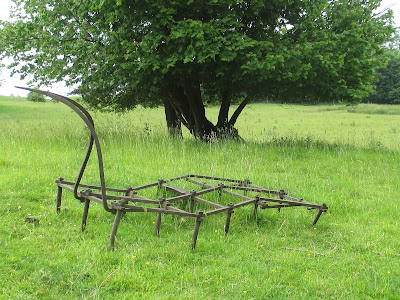It's amazing what you can see on a short walk even in mid-October if you just take your time. A brisk walk certainly brings cardio-vascular benefits but it's also great to feed the soul with a short leisurely stroll now-and-then which is what I did today. It was just a 2-miler but took a couple of hours simply because I was enjoying the wonderful charm and diversity of nature that our lovely English countryside has to offer. So I chose a walk in the lovely county of Shropshire betwixt the historically interesting village of Ryton and the tiny and quintessentially English hamlet of Grindleforge.
It starts by following a Permissive Path alongside Wesley Brook (which appears to be a popular sheep-run too) as it meanders generally south through to meet up with the River Worfe which flows into the River Severn near Bridgnorth. On reaching Grindleforge I took the top path back to Ryton. A lovely little walk that I can truly recommend. I saw not one person during the whole walk.
Many species of fungi were to be seen. I was fortunate to find a large Field Mushroom growing just in front of a sandy badger sett underneath a fine Field Maple tree, breakfast tomorrow! (No pic I'm afraid). There were many others to marvel at.
Shaggy Ink Caps
Looking across towards Ironbridge and a sight we won't soon be able to see; the Power Station chimney.
A bumble bee filling up her reserves for the winter hibernation
A lovely view on the approach to Ryton with the church peeping over the trees and the splendid house built by Italian Romollo Piazzani in the late 1800's. He died in1932 aged 60 and is buried in the churchyard overlooking his rather grand house in front of a sandstone column monument to his name. He was a landscape gardener and an artist. There's apparently a portrait of him hanging in the Scottish National Portrait Gallery, Edinburgh.
He appears to share the grave with the reverand Henry Pole Fraser MA the rector of the parish for 37 years who died aged 84 in 1977.
Badger Sett
Spotted two 7-spot ladybirds and a Green Shield Bug soon to be turning a purplish brown colour for the winter.

There are still quite a few butterflies around.I saw around 8 Red Admirals and a single Comma mainly on flowering ivy at the side of Wesley Brook approaching Grindleforge. This is one of the last and very important nectaring plants for these beautiful insects before they bed down for the long hibernating sleep where they will emerge early spring to start their frantic search for nectar once again, after which they will mate and die but they will have forged the first brood of the season. A Green-veined White was also spotted in flight. Also two Hornets and a few wasps all on the same flowering ivy along with Honey bees.
Wild flowers were still in profusion including Himalayan Balsam, Red Campion, Lords and Ladies, Borage, Cat's Ear and Mouse Ear,
Birds seen; Crows,Starlings, Dunnocks, Buzzards, Long-Tailed Tits, Kestrels and the ubiquitous Pigeons

The old bridge at Ryton is interesting. It is very similar to the one at Grindleforge. I'm sure this is an old packhorse bridge because if you look at the construction there is an added layer above the original coping stones. Packhorse bridges were usually built with narrow crossings and very low walls to allow the panniers on the heavily-laden horses to ride over the tops. But here's the dilemma with these two bridges, the Ryton one stretches 21' from wall to wall, much wider than a packhorse bridge would be, so was one of the wall's moved at some point on a necessary road-widening exercise as the motorcar succeeded the packhorse, possibly at the same time of wall-heightening? This is purely conjecture on my part and I have no evidence to support the theory but it's interesting all the same.
And a final little note about our threatened Hedgehogs, this was a poster from the Hedgehog Preservation Society that I came across at Ryton Church: Don't put out bread and milk, it's not good for their stomachs. Instead leave special hedgehog food, chopped unsalted peanuts, or meaty cat food and only water to drink. They walk up to a mile at night foraging so try to leave a hole in fences and walls to give them more variety a 13cm square hole is recommended. They are the gardeners friends as they eat our snails and slugs.
So, all-in-all a lovely walk on a warm and sunny mid-October day. Highly recommended if you just want to stroll and enjoy what the countryside has to offer.
















































